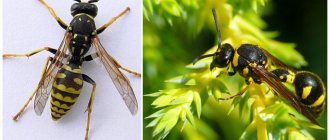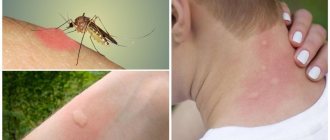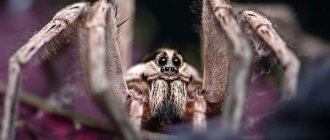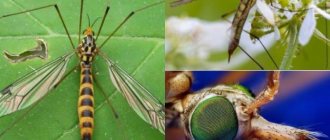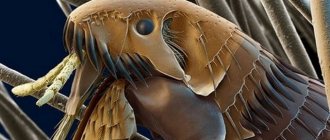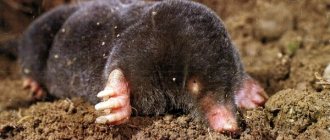- How long do mosquitoes live?
And why didn’t Noah kill those two mosquitoes then?
If the hero of our last article from the “zoology” section is
The ladybug is a very positive insect, then certainly little positive can be said about the hero of today’s article - the mosquito. But you can say a lot of interesting things, for example, the mosquito is a very ancient representative of the fauna of our planet, these small flying bloodsuckers bothered dinosaurs, and even in our time they are no less annoying.
Mosquito: description, structure, characteristics. What does a mosquito look like?
The mosquito belongs to the order Diptera and the family of blood-sucking mosquitoes. Mosquitoes have lived on Earth for as much as 145 million years.
The mosquito has a thin body from 4 to 14 mm in length. The wings of a mosquito are transparent, they reach up to 3 cm in diameter and are covered with small scales. The mosquito's abdomen consists of ten segments. The mosquito's long legs end in two claws.
The color of a mosquito, in addition to the usual black or brown, can also be very unusual; green, yellow, orange and red mosquitoes are found in nature.
Interesting fact: among the large family of mosquitoes, there are also wingless species.
Mosquitoes also have a kind of antenna, consisting of 15 parts, on which the olfactory organs and auditory receptors are located, working on the principle of a temperature sensor. It is with the help of such an antenna that the mosquito finds its victim.
Miracles of body structure
It is difficult to determine the exact mass of a mosquito, since its value is largely determined by the amount of food eaten. But there are still averages:
- a hungry insect weighs no more than 2 mg;
- Well-fed weight can reach from 3 to 5 mg.
Many people are interested in the question of how many legs a mosquito has. He has three pairs of legs, like most insects on our planet. Each tarsus consists of five segments, and the last one necessarily has suckers, which are developed differently in each specific species.
However, it is not the number of legs that is of interest, but those very suction cups that allow the mosquito to calmly hold its body on vertical surfaces.
Oral apparatus
The mouthparts of a mosquito are no less interesting. It consists of two pairs of jaws and two lips - upper and lower. The lips of this insect are slightly elongated and, having such a structure, resemble a gutter. If you look inside it, you can find long needles that are jaws.
So, these insects have jaws, lips and even a tongue that produces saliva. And here a reasonable question arises: do mosquitoes have teeth? And what’s surprising is that there is. They are very small, and their number reaches 50 pieces. It is thanks to them that the bloodsucker can pierce the skin.
Another amazing feature of these insects is the ability to squeak in the absence of a voice. So, why does a mosquito squeak? In fact, the squeak is not the result of the vocal cords, but the sound it makes with its wings.
Why doesn’t a mosquito buzz, but rather squeak? It's all about size. His wings, like himself, are very small and also quite thin and narrow. Each wing beat merges with the sound of the next beat, generating a high-frequency sound that our ear perceives as a squeak. How many flaps per second does a mosquito make? Their frequency is incredibly high and amounts to about 600 times per second!
Some interesting facts about mosquito squeaks:
- this sound helps females attract males during mating;
- mosquitoes hear not a squeak, but vibrations of sound that they pick up with their antennae;
- in females the squeak is somewhat thinner than in males;
- The squeak of young females differs from the sound of adults, and it is precisely based on these differences that the male chooses a mate for himself - a more mature female.
The body size of these insects is quite small - from 0.5 to 1.5 cm. However, their abdomen has the ability to swell, thanks to which they can drink relatively much blood. They are helped in this by their long proboscis, which can easily pierce not only skin, but also clothing.
You can distinguish mosquitoes from other insects by many characteristics. For example, by their elongated limbs, against which their body looks tiny. Or by the low-frequency squeak that insects make when their wings move. The fact is that the insect itself is small, and its wings are too long and thin. As a result, such a squeak occurs during flight.
There are 4 main stages in the life cycle of a blood-sucking insect:
- Mosquito eggs.
- Small larva. It is similar in body structure to a worm. Avid fishermen often call the larvae bloodworms, and also use them to feed aquarium and river fish.
- Doll.
- Imago or adult individual. How much an adult mosquito weighs depends on the species.
The length of a mosquito's life cycle depends on the species. Some varieties live 2–3 months, others up to a year.
The structure of a mosquito is standard. It has a thin body, the length of which is 0.4-1.4 cm. Almost all varieties have long legs and working wings. People often confuse the Culexes they encounter indoors or in the forest with the Caramors (long-legged ones). Although centipedes with long limbs have an unpleasant appearance, they feed only on plant foods.
Blood-sucking insects have two pairs of wings with dark spots. The second pair of mosquito wings is practically not used. During flight, the insect makes up to 900-1,000 strokes. When approaching a person, you get the feeling that mosquitoes are squeaking. This effect occurs due to the fact that the insect makes a huge number of flapping of its wings. That's why blood-sucking mosquitoes squeak and people hear this sound.
When examining an insect under a microscope or magnifying glass, you can see the abdomen, which is divided into segments or strips. The number of stripes depends on the species. The chest is wide because it covers the internal organs. To study the insides, scientists made a cut. The legs of a mosquito are supplemented with claws, with the help of which it attaches to various bases and human skin.
The head of a mosquito has a unique structure. The tactile organs, which include the antennae, are concentrated on it. The structure of the antennae is relatively simple. Each antenna includes about 15 segments, with the help of which space is studied. This difference between a mosquito and a squeak must be taken into account. Black and white eyes are concentrated on the head, with the help of which pests can see objects and find a victim. The mouthparts of a blood-sucking mosquito have a special structure. The weight of a blood-sucking insect is about 2.5-3 years.
We suggest you read: How to properly remove bedbugs
The mosquito belongs to the order Diptera and the family of blood-sucking mosquitoes. Mosquitoes have lived on Earth for as much as 145 million years.
The mosquito has a thin body from 4 to 14 mm in length. The wings of a mosquito are transparent, they reach up to 3 cm in diameter and are covered with small scales. The mosquito's abdomen consists of ten segments. The mosquito's long legs end in two claws.
The color of a mosquito, in addition to the usual black or brown, can also be very unusual; green, yellow, orange and red mosquitoes are found in nature.
Interesting fact: among the large family of mosquitoes, there are also wingless species.
Mosquitoes also have a kind of antenna, consisting of 15 parts, on which the olfactory organs and auditory receptors are located, working on the principle of a temperature sensor. It is with the help of such an antenna that the mosquito finds its victim.
Mosquito eyes
The mosquito's eyes are scalloped and consist of many ommatidia.
Rice. 5. The mosquito's eyes are scalloped and consist of many ommatidia.
Oral apparatus
The oral apparatus of mosquitoes is a piercing and cutting instrument represented by a proboscis, which consists of the upper and lower lips, the hypopharynx (subpharynx) and two pairs of upper (mandibles) and lower (maxilla) jaws.
The lower lip is a tube. It serves as a support for stabbing stilettos. Blood passes through it as it is absorbed. Blood is consumed only by females, for whom it serves as a nutrient for the maturation of eggs. Males feed only on plant juices, so the piercing parts of their oral apparatus are atrophied.
The organs of touch and taste in mosquitoes are 5-segmented palps extending from the base of the lower jaws. Their length and shape serve as distinctive features of malarial and non-malarial mosquitoes: in malarial mosquitoes, the palps and the length of the proboscis are equal in length and have club-shaped thickenings at the ends; in non-malarial mosquitoes, the palps are longer than the proboscis and do not have club-shaped thickenings at the ends.
Rice. 6. The structure of malaria mosquitoes.
Antennas
Antennas or antennae located on the front surface of the head perform the function of recognizing smells and touch. In males, the antennae are covered with thick and fluffy hairs, in females they are short and sparse.
The malaria mosquito has a pair of wings, three pairs of thin legs and halteres, which are attached to the mosquito's chest.
Mosquito wings
The wings of malaria mosquitoes are elongated-oval with a large number of transverse and longitudinal veins, covered with microtrichia (small hairs). Different types of mosquitoes have their own patterns. Malaria mosquitoes have 4 brown spots on their wings. Non-malarial mosquitoes have alternating dark and light spots.
Abdomen
The abdomen of mosquitoes consists of ten segments, the ninth and tenth of which form part of the external genitalia. The body of mosquitoes is elongated, the head is small, and the legs are long. When landing, mosquitoes of the genus Anopheles have the posterior part of the abdomen raised; in non-malarial mosquitoes, the abdomen is parallel to the skin.
Rice. 7. Bite of female malarial (photo on the left) and non-malarial (photo on the right) mosquitoes.
Rice. 8. The structure of a mosquito of the genus Culex (picture on the left) and Anopheles (photo on the right).
Where do mosquitoes live?
Almost everywhere, except always cold
Antarctica, but these insects are most common in areas with a hot and humid climate, where they remain active throughout the year. In temperate latitudes, during the winter cold, they hibernate, awakening with the arrival of spring. It is interesting that even in the Arctic, during those few weeks when it gets warm, mosquitoes breed with terrible force and are very annoying to the herds of deer there.
Enemies of mosquitoes
Of course, mosquitoes themselves have many enemies in natural conditions, and they and their larvae are a tasty treat for many insects, birds, fish and amphibians:
frogs, newts, salamanders, dragonflies, spiders, bats, water mites, lizards.
It is also very interesting that the larvae of mosquitoes often feed on the larvae of insects such as the swimming beetle and dragonfly.
Types of mosquitoes, photos and names
There are a great many different types of mosquitoes in nature; we will describe the most interesting of them:
Common mosquito (squeaker)
It is the most common representative of the mosquito family. It lives over a wide geographic range; it is these mosquitoes that often bother us during forest picnics, walks near water bodies, or even just at home.
Centipede mosquito (caramora)
These mosquitoes live exclusively in places with high humidity: near ponds, swamps, and in shady thickets. They are large in size for mosquitoes - reaching 4-8 cm in length. And these mosquitoes are also safe for humans, since they feed exclusively on nectar and plant juices, but they can cause harm to farmland and forest plantings.
Anopheles mosquito
This type of mosquito is perhaps the most dangerous among all, since it is a carrier of the most dangerous parasites - malarial plasmodium, which causes malaria. It is similar in size and appearance to a regular mosquito, the only thing that distinguishes it is its longer hind legs.
Chionei (winter mosquitoes)
These mosquitoes are similar to both large spiders and centipedes. However, they differ from both of them in their way of life. They differ from other mosquitoes in their ability to tolerate cold and therefore winter mosquitoes can be found even in winter.
Mosquito Dergun
Also known as the bell mosquito. It is a harmless representative of the mosquito family, as it feeds exclusively on plant foods. It lives mainly along the banks of water bodies. It differs from other mosquitoes in its appearance - it has a yellowish-green color with long limbs.
Mosquitoes are useful!
It would seem, what could be the benefit of mosquitoes? They only fly and bite, while also carrying some diseases. But in fact, these insects are unique creatures of nature, according to the laws of which nothing can happen for nothing.
- Firstly, mosquitoes are food for fish, birds, other large insects, newts and many species of other animals, and therefore represent the stability of the food cycle.
- Secondly, these ubiquitous insects occupy by no means the last place in the ecological balance, since after turning into an adult insect they take important microelements from water bodies and enrich the soil with them after their death.
- Thirdly, males, feeding on nectar, contribute to the pollination of plants by carrying pollen on their paws.
- Fourthly, a mosquito, simply feeding on blood, supplies it with anticoagulants that reduce clotting, and this is useful for people suffering from diseases associated with high platelet levels.
And even if the scientific facts and compelling arguments regarding the benefits of mosquitoes are never discovered, you know enough that such a simple and sometimes annoying mosquito deserves your respect.
Mosquito breeding
The life cycle of a mosquito consists of four stages of development:
First, the males fly out into the light, having gathered in a swarm, they wait for females to mate. After mating, the fertilized female goes in search of blood, which she needs to lay her eggs.
What do mosquitoes eat?
Many people assume that regular mosquitoes and mosquitoes only feed on lymph. This is only partially true, since males and females have different eating preferences. The female mosquito bites animals and people in order to get a certain portion of protein. She needs this component for normal reproduction.
Active blood consumption has a scientific basis. Some people wrote a report and prepared scientific calculations. They contain brief information about dietary preferences, which serves as food for male and female mosquitoes. After all, blood-sucking pests do not attack all people.
It’s probably no secret to anyone that only female mosquitoes suck blood, while males are completely harmless creatures. Male mosquitoes feed exclusively on nectar or plant sap.
But for the reproduction of offspring, females need protein food, which they get from the blood of both people and animals.
How to get rid of mosquitoes at home
Sometimes mosquitoes have a bad habit of entering houses, bothering people in every possible way. As a means of protection against mosquitoes, people have developed many means, among which special mosquito nets are very useful, preventing mosquitoes from entering the house through open windows.
Another effective remedy for mosquitoes can be special repellents, substances that emit odors that repel mosquitoes, although their disadvantage may be that the smells of repellents can have a bad effect not only on mosquitoes, but also on people.
A pot of geranium is quite suitable as a folk remedy for fighting mosquitoes, whose smell also repels these flying bloodsuckers.
Malaria mosquitoes / Anopheles
Let's complete the list with dipteran insects, which are carriers of malarial plasmodia. They live everywhere except waterless deserts, Antarctica and the white silence of the Far North.
Malaria mosquitoes are often confused with centipedes. But centipedes drink plant nectar and are all harmless to humans, unlike their dangerous little brothers. It’s interesting, but even such small creatures have teeth, but they can only be seen under a microscope.
?
Interesting facts about mosquitoes
- It was the mosquito that played a key role in the good old science fiction film “Jurassic Park”; through the blood found in an ancient mosquito trapped in amber, scientists were able to access the DNA of dinosaurs and thus “resurrect” these prehistoric lizards.
- The flight speed of a mosquito is on average 3.2 km per hour, but skillfully using air currents, mosquitoes are able to fly up to 100 km.
- The mosquito's weight is so small that once it hits the web it will not cause vibrations and will not attract the spider's attention.
